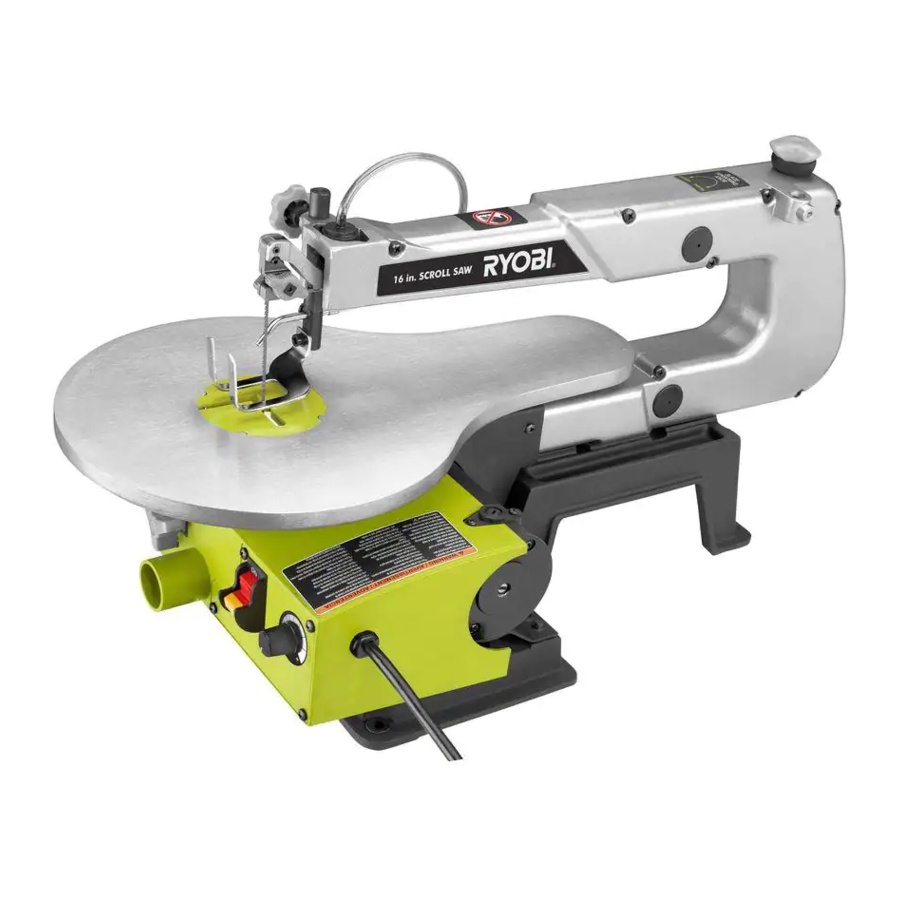
Advertisement
- 1 GENERAL SAFETY RULES
- 2 SPECIFIC SAFETY RULES
- 3 SYMBOLS
- 4 ELECTRICAL
- 5 GLOSSARY OF TERMS
- 6 FEATURES
-
7
ASSEMBLY
- 7.1 TOOLS NEEDED
- 7.2 UNPACKING
- 7.3 LOOSE PART LIST
- 7.4 REDUCING NOISE AND VIBRATION
- 7.5 MOUNTING THE UNIT TO WORKBENCH
- 7.6 CLAMPING THE UNIT TO WORKBENCH
- 7.7 SAWDUST BLOWER
- 7.8 DROP FOOT
- 7.9 SQUARING THE SAW TABLE TO THE BLADE
- 7.10 SETTING THE TABLE FOR HORIZONTAL OR BEVEL CUTTING
- 7.11 ADJUSTING BLADE TENSION
-
8
OPERATION
- 8.1 APPLICATIONS
- 8.2 BASIC OPERATION OF THE UNIT
- 8.3 CUTTING PROCEDURES
- 8.4 REMOVING JAMMED MATERIAL
- 8.5 AVOIDING INJURY
- 8.6 LOCKING THE SWITCH
- 8.7 INSTALLING AND REMOVING BLADES
- 8.8 PIN END BLADES
- 8.9 PLAIN END BLADES
- 8.10 BLADE INFORMATION
- 8.11 CHOICE OF BLADE AND SPEED
- 8.12 USING VARIABLE SPEED
- 8.13 SCROLL CUTTING
- 8.14 INTERIOR SCROLL CUTTING
- 8.15 STACK CUTTING
- 9 MAINTENANCE
- 10 TROUBLESHOOTING
- 11 Documents / Resources

GENERAL SAFETY RULES
 WARNING:
WARNING:
Read and understand all instructions. Failure to follow all instructions listed below, may result in electric shock, fire and/or serious personal injury.
READ ALL INSTRUCTIONS
- KNOW YOUR POWER TOOL. Read the operator's manual carefully. Learn the applications and limitations as well as the specific potential hazards related to this tool.
- GUARD AGAINST ELECTRICAL SHOCK BY PREVENTING BODY CONTACT WITH GROUNDED SURFACES. For example: pipes, radiators, ranges, refrigerator enclosures.
- KEEP GUARDS IN PLACE and in good working order.
- REMOVE ADJUSTING KEYS AND WRENCHES. Form habit of checking to see that keys and adjusting wrenches are removed from tool before turning it on.
- KEEP WORK AREA CLEAN. Cluttered areas and benches invite accidents. DO NOT leave tools or pieces of wood on the tool while it is in operation.
- DO NOT USE IN DANGEROUS ENVIRONMENTS. Do not use power tools in damp or wet locations or expose to rain. Keep the work area well lit.
- KEEP CHILDREN AND VISITORS AWAY. All visitors should wear safety glasses and be kept a safe distance from work area. Do not let visitors contact tool or extension cord while operating.
- MAKE WORKSHOP CHILDPROOF with padlocks, master switches, or by removing starter keys.
- DON'T FORCE THE TOOL. It will do the job better and safer at the feed rate for which it was designed.
- USE THE RIGHT TOOL. Do not force the tool or attachment to do a job for which it was not designed.
- USE THE PROPER EXTENSION CORD. Make sure your extension cord is in good condition. Use only a cord heavy enough to carry the current your product will draw. An undersized cord will cause a drop in line voltage resulting in loss of power and overheating. A wire gauge size (A.W.G.) of at least 16 is recommended for an extension cord 25 feet or less in length. If in doubt, use the next heavier gauge. The smaller the gauge number, the heavier the cord.
- DRESS PROPERLY. Do not wear loose clothing, gloves, neckties, or jewelry. They can get caught and draw you into moving parts. Also wear protective hair covering to contain long hair.
- ALWAYS WEAR SAFETY GLASSES WITH SIDESHIELDS. Everyday eyeglasses have only impact- resistant lenses, they are NOT safety glasses.
- SECURE WORK. Use clamps or a vise to hold work when practical, it is safer than using your hand and frees both hands to operate the tool.
- DO NOT OVERREACH. Keep proper footing and balance at all times.
- MAINTAIN TOOLS WITH CARE. Keep tools sharp and clean for better and safer performance. Follow instructions for lubricating and changing accessories.
- DISCONNECT TOOLS. When not in use, before servicing, or when changing attachments, blades, bits, cutters, etc., all tools should be disconnected from power source.
- AVOID ACCIDENTAL STARTING. Be sure switch is off when plugging in any tool.
- USE RECOMMENDED ACCESSORIES. Consult the operator's manual for recommended accessories. The use of improper accessories may result in injury.
- NEVER STAND ON TOOL. Serious injury could occur if the tool is tipped.
- CHECK DAMAGED PARTS. Before further use of the tool, a guard or other part that is damaged should be carefully checked to determine that it will operate properly and perform its intended function. Check for alignment of moving parts, binding of moving parts, breakage of parts, mounting and any other conditions that may affect its operation. A guard or other part that is damaged must be properly repaired or replaced by an authorized service center to avoid risk of personal injury.
- USE THE RIGHT DIRECTION OF FEED. Feed work into a blade, cutter, or sanding spindle against the direction or rotation of the blade, cutter, or sanding spindle only.
- NEVER LEAVE TOOL RUNNING UNATTENDED. TURN THE POWER OFF. Don't leave tool until it comes to a complete stop.
- PROTECT YOUR LUNGS. Wear a face or dust mask if the cutting operation is dusty.
- PROTECT YOUR HEARING. Wear hearing protection during extended periods of operation.
- DO NOT ABUSE CORD. Never carry tool by the cord or yank it to disconnect from receptacle. Keep cord from heat, oil, and sharp edges.
- ALWAYS USE AN OUTDOOR EXTENSION CORD MARKED "W-A" OR "W". These cords are rated for outdoor use and reduce the risk of electric shock.
- KEEP BLADES CLEAN, SHARP, AND WITH SUFFICIENT SET. Sharp blades minimize stalling and kickback.
- BLADE COASTS AFTER BEING TURNED OFF.
- NEVER USE IN AN EXPLOSIVE ATMOSPHERE. Normal sparking of the motor could ignite fumes.
- INSPECT TOOL CORDS PERIODICALLY. If damaged, have repaired by a qualified service technician at an authorized service facility. The conductor with insulation having an outer surface that is green with or without yellow stripes is the equipment-grounding conductor. If repair or replacement of the electric cord or plug is necessary, do not connect the equipment-grounding conductor to a live terminal. Repair or replace a damaged or worn cord immediately. Stay constantly aware of cord location and keep it well away from the rotating blade.
- INSPECT EXTENSION CORDS PERIODICALLY and replace if damaged.
- GROUND ALL TOOLS. If tool is equipped with threeprong plug, it should be plugged into a three-hole electrical receptacle.
- CHECK WITH A QUALIFIED ELECTRICIAN or service personnel if the grounding instructions are not completely understood or if in doubt as to whether the tool is properly grounded.
- USE ONLY CORRECT ELECTRICAL DEVICES: 3-wire extension cords that have 3-prong grounding plugs and 3-pole receptacles that accept the tool's plug.
- DO NOT MODIFY the plug provided. If it will not fit the outlet, have the proper outlet installed by a qualified electrician.
- KEEP TOOL DRY, CLEAN, AND FREE FROM OIL AND GREASE. Always use a clean cloth when cleaning. Never use brake fluids, gasoline, petroleum-based products, or any solvents to clean tool.
- STAY ALERT AND EXERCISE CONTROL. Watch what you are doing and use common sense. Do not operate tool when you are tired. Do not rush.
- DO NOT USE TOOL IF SWITCH DOES NOT TURN IT ON AND OFF. Have defective switches replaced by an authorized service center.
- USE ONLY CORRECT BLADES.
- BEFORE MAKING A CUT, BE SURE ALL ADJUSTMENTS ARE SECURE.
- BE SURE BLADE PATH IS FREE OF NAILS. Inspect for and remove all nails from lumber before cutting.
- NEVER TOUCH BLADE or other moving parts during use.
- NEVER START A TOOL WHEN ANY ROTATING COMPONENT IS IN CONTACT WITH THE WORKPIECE.
- DO NOT OPERATE A TOOL WHILE UNDER THE INFLUENCE OF DRUGS, ALCOHOL, OR ANY MEDICATION.
- WHEN SERVICING use only identical replacement parts. Use of any other parts may create a hazard or cause product damage.
- USE ONLY RECOMMENDED ACCESSORIES listed in this manual or addendums. Use of accessories that are not listed may cause the risk of personal injury. Instructions for safe use of accessories are included with the accessory.
- DOUBLE CHECK ALL SETUPS. Make sure blade is tight and not making contact with saw or workpiecebefore connecting to power supply.
SPECIFIC SAFETY RULES
- FIRMLY CLAMP OR BOLT the tool to a workbench or table at approximately hip height.
- KEEP HANDS AWAY FROM CUTTING AREA. Do not reach underneath work or in blade cutting path with hands and fingers for any reason. Always turn the power off.
- BE SURE THE BLADE CLEARS THE WORKPIECE. Never start the saw with the blade touching the workpiece. Allow motor to come up to full speed before starting cut.
- MAKE SURE THE WORK AREA HAS AMPLE LIGHTING to see the work and that no obstructions will interfere with safe operation BEFORE performing any work using the saw.
- ALWAYS TURN OFF THE SAW before disconnecting it to avoid accidental starting when reconnecting to power supply. NEVER leave the saw unattended while connected to a power source.
- TURN OFF TOOL and wait for saw blade to come to a complete stop before moving workpiece or changing settings.
- IF THE POWER SUPPLY CORD IS DAMAGED, it must be replaced only by the manufacturer or by an authorized service center to avoid risk.
- ALWAYS SUPPORT LARGE WORKPIECES while cutting to minimize risk of blade pinching and kickback. Saw may slip, walk or slide while cutting large or heavy boards.
- SAVE THESE INSTRUCTIONS. Refer to them frequently and use them to instruct other users. If you loan someone this tool, loan them these instructions also.
SYMBOLS
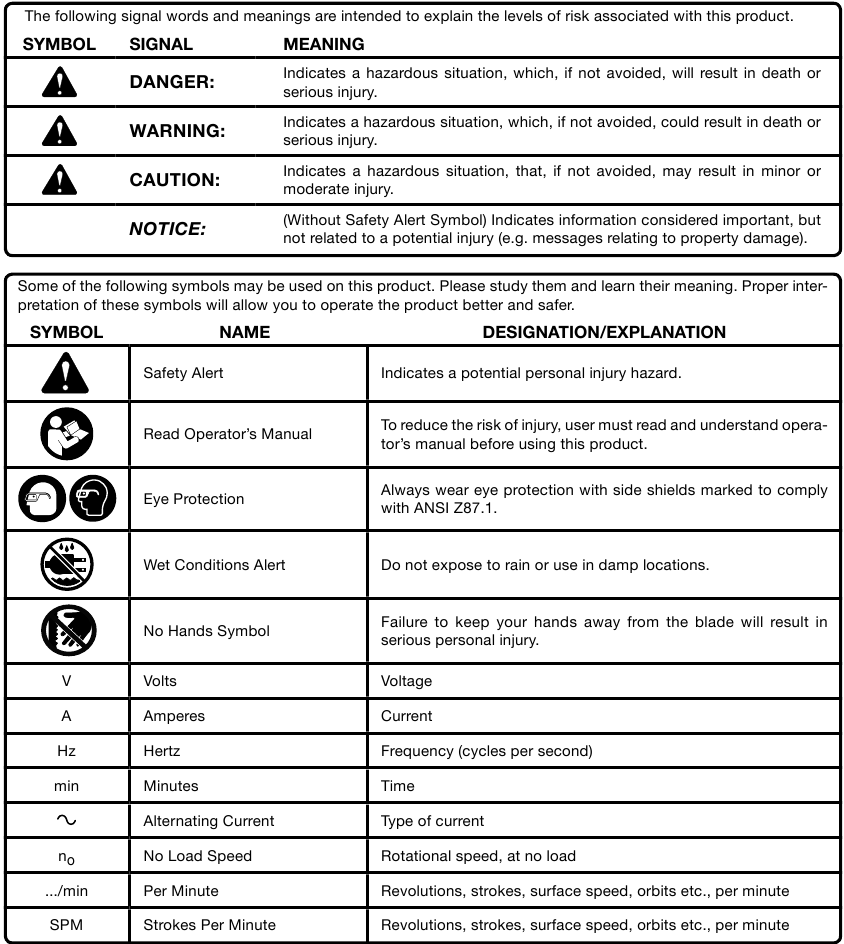
ELECTRICAL
EXTENSION CORDS
Use only 3-wire extension cords that have 3-prong grounding plugs and 3-pole receptacles that accept the tool's plug. When using a power tool at a considerable distance from the power source, use an extension cord heavy enough to carry the current that the tool will draw. An undersized extension cord will cause a drop in line voltage, resulting in a loss of power and causing the motor to overheat. Use the chart provided below to determine the minimum wire size required in an extension cord. Only round jacketed cords listed by Underwriter's Laboratories (UL) should be used.
| **Ampere rating (on tool faceplate) | ||||||
| 0-2.0 | 2.1-3.4 | 3.5-5.0 | 5.1-7.0 | 7.1-12.0 | 12.1-16.0 | |
| Cord Length | Wire Size (A.W.G.) | |||||
| 25' | 16 | 16 | 16 | 16 | 14 | 14 |
| 50' | 16 | 16 | 16 | 14 | 14 | 12 |
| 100' | 16 | 16 | 14 | 12 | 10 | — |
**Used on 12 gauge - 20 amp circuit.
NOTE: AWG = American Wire Gauge
When working with the tool outdoors, use an extension cord that is designed for outside use. This is indicated by the letters "W-A" or "W" on the cord's jacket.
Before using an extension cord, inspect it for loose or exposed wires and cut or worn insulation.
 WARNING:
WARNING:
Keep the extension cord clear of the working area. Position the cord so that it will not get caught on lumber, tools or other obstructions while you are working with a power tool. Failure to do so can result in serious personal injury.
 WARNING:
WARNING:
Check extension cords before each use. If damaged replace immediately. Never use product with a damaged cord since touching the damaged area could cause electrical shock resulting in serious injury.
ELECTRICAL CONNECTION
This product is powered by a precision built electric motor. It should be connected to a power supply that is 120 V, AC only (normal household current), 60 Hz. Do not operate this product on direct current (DC). A substantial voltage drop will cause a loss of power and the motor will overheat. If the saw does not operate when plugged into an outlet, double check the power supply.
SPEED AND WIRING
The no-load speed of this tool is approximately 1,600 spm. This speed is not constant and decreases under a load or with lower voltage. For voltage, the wiring in a shop is as important as the motor's horsepower rating. A line intended only for lights cannot properly carry a power tool motor. Wire that is heavy enough for a short distance will be too light for a greater distance. A line that can support one power tool may not be able to support two or three tools.
GROUNDING INSTRUCTIONS
This product must be grounded. In the event of a malfunction or breakdown, grounding provides a path of least resistance for electric current to reduce the risk of electric shock. This tool is equipped with an electric cord having an equipment-grounding conductor and a grounding plug. The plug must be plugged into a matching outlet that is properly installed and grounded in accordance with all local codes and ordinances.
Do not modify the plug provided. If it will not fit the outlet, have the proper outlet installed by a qualified electrician.
 WARNING:
WARNING:
Improper installation of the grounding plug can result in a risk of electric shock. When repair or replacement of the cord is required, do not connect the grounding wire to either flat blade terminal. The wire with insulation having an outer surface that is green with or without yellow stripes is the grounding wire.
Check with a qualified electrician or service personnel if the grounding instructions are not completely understood, or if in doubt as to whether the tool is properly grounded.
Repair or replace a damaged or worn cord immediately.
This product is for use on a nominal 120 volt circuit and has a grounding plug similar to the plug illustrated in figure 1.
Only connect the product to an outlet having the same configuration as the plug. Do not use an adapter with this product.

- Grounding pin
- Ground fault outlet
GLOSSARY OF TERMS
Anti-Kickback Pawls (radial arm and table saws)
A device which, when properly installed and maintained, is designed to stop the workpiece from being kicked back toward the front of the saw during a ripping operation.
Arbor
The shaft on which a blade or cutting tool is mounted.
Bevel Cut
A cutting operation made with the blade at any angle other than 90° to the table surface.
Compound Cut
A cross cut made with both a miter and a bevel angle.
Cross Cut
A cutting or shaping operation made across the grain or the width of the workpiece.
Cutterhead (planers and jointer planers)
A rotating cutterhead with adjustable blades or knives. The blades or knives remove material from the workpiece.
Dado Cut
A non-through cut which produces a square-sided notch or trough in the workpiece (requires a special blade).
Featherboard
A device used to help control the workpiece by holding it securely against the table or fence during any ripping operation.
FPM or SPM
Feet per minute (or strokes per minute), used in reference to blade movement.
Freehand
Performing a cut without the workpiece being guided by a fence, miter gauge, or other aids.
Gum
A sticky, sap-based residue from wood products.
Heel
Alignment of the blade to the fence.
Kerf
The material removed by the blade in a through cut or the slot produced by the blade in a non-through or partial cut.
Kickback
A hazard that can occur when the blade binds or stalls, throwing the workpiece back toward operator.
Miter Cut
A cutting operation made with the workpiece at any angle to the blade other than 90°.
Non-Through Cuts
Any cutting operation where the blade does not extend completely through the thickness of the workpiece.
Pilot Hole (drill presses)
A small hole drilled in a workpiece that serves as a guide for drilling large holes accurately.
Push Blocks (for jointer planers)
Device used to feed the workpiece over the jointer planer cutterhead during any operation. This aid helps keep the operator's hands well away from the cutterhead.
Push Blocks (for table saws)
Device used to hold the workpiece during cutting operations. This aid helps keep the operator's hands well away from the blade.
Push Sticks (for table saws)
Device used to push the workpiece during cutting operations. A push stick should be used for narrow ripping operations. The aid helps keep the operator's hands well away from the blade.
Resaw
A cutting operation to reduce the thickness of the workpiece to make thinner pieces.
Resin
A sticky, sap-based substance that has hardened.
Revolutions Per Minute (RPM)
The number of turns completed by a spinning object in one minute.
Ripping or Rip Cut
A cutting operation along the length of the workpiece.
Riving Knife/Spreader/Splitter (table saws)
A metal piece, slightly thinner than the blade, which helps keep the kerf open and also helps to prevent kickback.
Saw Blade Path
The area over, under, behind, or in front of the blade. As it applies to the workpiece, that area which will be or has been cut by the blade.
Set
The distance that the tip of the saw blade tooth is bent (or set) outward from the face of the blade.
Snipe (planers)
Depression made at either end of a workpiece by cutter blades when the workpiece is not properly supported.
Taper Cut
A cut where the material being cut has a different width at the beginning of the cut from the the end.
Through Sawing
Any cutting operation where the blade extends completely through the thickness of the workpiece.
Throw-Back
The throwing back of a workpiece usually caused by the workpiece being dropped into the blade or being placed inadvertently in contact with the blade.
Workpiece or Material
The item on which the operation is being done.
Worktable
Surface where the workpiece rests while performing a cutting, drilling, planing, or sanding operation.
FEATURES
PRODUCT SPECIFICATIONS
| Throat | 16 in. |
| Blade Length | 5 in., pin or plain |
| Input | 120 V~, AC Only, 60 Hz 1.2 A |
| No Load Speed | 550-1,650 r/min. (SPM) |
KNOW YOUR PRODUCT

- Blade tension knob
- Drop foot lock knob
- Saw dust blower
- Saw blade
- Saw table
- Throat plate
- Variable speed knob
- Switch and switch key
- Sawdust exhaust
- Bevel lock knob
- Bevel scale
- Drop foot
- Blade(s)
- T-handle hex key
- Blade clamp storage
The safe use of this product requires an understanding of the information on the product and in this operator's manual as well as a knowledge of the project you are attempting. Before use of this product, familiarize yourself with all operating features and safety rules.
BEVEL SCALE
The bevel scale and indicator show you the degree the saw table is tilted.
BLADE TENSION KNOB
Loosen or tighten the blade tension by turning the blade tension knob.
DROP FOOT
This foot should always be lowered until it just rests on top of the workpiece to prevent the workpiece from lifting, yet not so much that the workpiece drags.
DROP FOOT LOCK KNOB
Allows you to raise or lower the drop foot and lock it in place.
SAWDUST BLOWER
Keeps the line of cut on the workpiece clean for more accurate scroll cuts. For best results, always direct air flow at the blade and the workpiece.
SAWDUST EXHAUST
This feature allows you to attach any 1-1/4 in. (32 mm) vacuum hose for easy sawdust collection.
SAW TABLE WITH THROAT PLATE
Your scroll saw has an aluminum saw table with tilt control for maximum accuracy. The throat plate, inserted in the saw table, allows for blade clearance.
SWITCH AND SWITCH KEY
Your scroll saw has an easy access power switch. To lock in the OFF position, remove the yellow switch key. Place the key in a location inaccessible to children and others not qualified to use the tool.
BEVEL LOCK KNOB
Allows you to tilt the table and lock it at the desired angle up to 45°.
VARIABLE SPEED KNOB
Turn the knob to adjust the speed from the high speed of approximately 1,650 r/min. (SPM) to the low speed of approximately 550 r/min. (SPM).
ASSEMBLY
TOOLS NEEDED
See Figure 2.
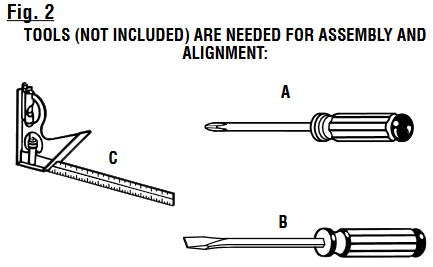
- Phillips Screwdriver
- Flathead Screwdriver
- Combination Square
UNPACKING
See Figure 3.
This product requires assembly.
- Carefully lift the saw from the carton and place on a level work surface.
 WARNING:
WARNING:
Do not use this product if any parts on the Loose Parts List are already assembled to your product when you unpack it. Parts on this list are not assembled to the product by the manufacturer and require customer installation. Use of a product that may have been improperly assembled could result in serious personal injury.
- Inspect the tool carefully to make sure no breakage or damage occurred during shipping.
- Do not discard the packing material until you have carefully inspected and satisfactorily operated the tool.
- The saw is factory set for accurate cutting. After assembling it, check for accuracy. If shipping has influenced the settings, refer to specific procedures explained in this manual.
- If any parts are damaged or missing, please call 1-800-525-2579 for assistance.
LOOSE PART LIST
Scroll Saw
Blade(s)
Switch Key
3 mm T-Handle Hex Key
Operator's Manual
 WARNING:
WARNING:
If any parts are damaged or missing do not operate this tool until the parts are replaced. Use of this product with damaged or missing parts could result in serious personal injury.
 WARNING:
WARNING:
Do not attempt to modify this tool or create accessories not recommended for use with this tool. Any such alteration or modification is misuse and could result in a hazardous condition leading to possible serious personal injury.
 WARNING:
WARNING:
Do not connect to power supply until assembly is complete. Failure to comply could result in accidental starting and possible serious personal injury.
REDUCING NOISE AND VIBRATION
You may wish to place a foam pad or piece of carpet between the saw base and the workbench to help reduce noise and vibration.
If a foam pad or piece of carpet is used, do not overtighten the mounting bolts. Leave some cushion between the padding and the saw base to help absorb the noise and vibration.
The size of the padding material should be approximately 24 in. x 12 in. x 1/2 in.
MOUNTING THE UNIT TO WORKBENCH
If the scroll saw is to be used in a permanent application, we recommend that you secure it in a permanent location such as a workbench. When mounting the saw to a workbench, holes should be drilled through the supporting surface of the workbench.
Each hole in the base of the saw should be bolted securely using machine bolts, washers, and nuts (not included). Bolts should be of sufficient length to accommodate the saw base, washers, nuts, and the thickness of the workbench.
- Place scroll saw on workbench. Using the saw base as a pattern, locate and mark the holes where the scroll saw is to be mounted.
- Drill four holes through the workbench.
- Place scroll saw on workbench aligning holes in the saw base with the holes drilled in the workbench.
- Insert all four bolts (not included) and tighten securely with washers and nuts (not included).
NOTE: All bolts should be inserted from the top. Install the washers and nuts from the underside of the bench.
Supporting surface where scroll saw is mounted should be examined carefully after mounting to insure that no movement during use can result. If any tipping or walking is noted, secure workbench or supporting surface before beginning cutting operations.
CLAMPING THE UNIT TO WORKBENCH
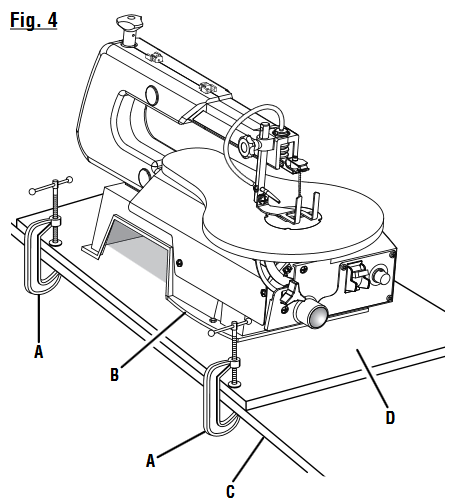
- C-clamp
- Saw base
- Workbench
- Mounting board
If the scroll saw is to be used in a portable application, it is recommended that you fasten it permanently to a mounting board that can easily be clamped to a workbench or other supporting surface. The mounting board should be of sufficient size to avoid tipping of saw while in use. Any good grade plywood or chipboard with a 3/4 in. thickness is recommended.
- Mount saw to board using holes in saw base as a template for hole pattern. Locate and mark the holes where scroll saw is to be mounted.
- Follow last three steps in previous section called "Mounting Scroll Saw to Workbench".
If lag bolts are being used, make sure they are long enough to go through holes in the saw base and the material the saw is being mounted to.
If machine bolts are being used, make sure they are long enough to go through holes in the saw base, the material the saw is being mounted to, and the washers and nuts.
NOTE: It may be necessary to countersink washers and nuts on the bottom side of mounting board.
SAWDUST BLOWER
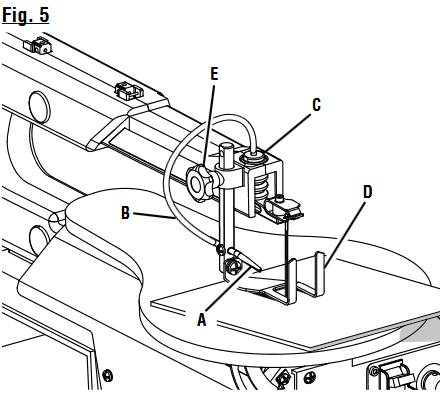
- Sawdust blower
- Plastic tubing
- Bellows tube
- Drop foot
- Drop foot lock knob
The sawdust blower is designed and preset to direct air to the most effective point on the cutting line. Be sure drop foot is properly adjusted to secure workpiece and direct air to the cutting surface.
- Plastic tubing should be connected to the bellows tube before starting the saw.
DROP FOOT
See Figure 5.
To prevent workpiece from lifting, the drop foot should be adjusted so it just rests on the top of the workpiece. The drop foot should not be adjusted so that the workpiece drags. Always retighten the drop foot lock knob after each adjustment has been made.
- Loosen the drop foot lock knob.
- Lower or raise the drop foot to the desired position.
- Retighten the drop foot lock knob.
The tall, front part of the drop foot acts as a blade guard to prevent accidental contact with the blade.
SQUARING THE SAW TABLE TO THE BLADE
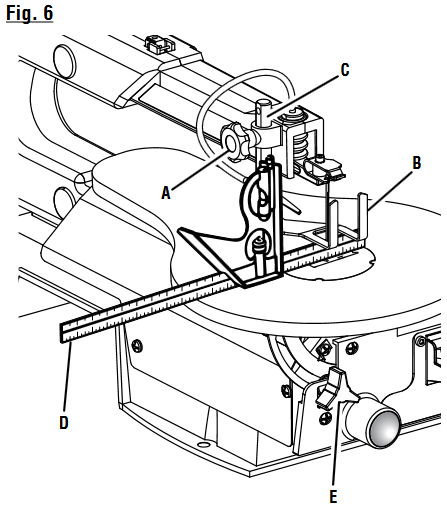
- Drop foot lock knob
- Drop foot
- Drop foot rod
- Combination square
- Table lock knob

- Bevel scale
- Scale indicator
- Table lock knob
- Screw
- Loosen the drop foot lock knob and move drop foot rod all the way up. Retighten drop foot lock knob.
- Loosen the table lock knob to tilt the saw table until it is approximately perpendicular or at right angle to the blade. n Place a small square on the saw table next to the blade.
- Loosen the screw holding the scale indicator. Move indicator to the 0° mark and securely tighten screw. Remember, the bevel scale is a convenient guide but should not be relied upon for precision. Make practice cuts on scrap material to determine if your angle settings are correct.
- Adjust the drop foot to desired position and securely retighten the drop foot lock knob.
SETTING THE TABLE FOR HORIZONTAL OR BEVEL CUTTING
See Figure 7.
A bevel scale is located under the saw table as a convenient guide for setting the approximate saw table angle for bevel cutting. When greater precision is required, make practice cuts on scrap material and adjust the saw table as necessary for your requirements.
NOTE: When cutting at angles, the drop foot should be tilted so it is parallel to the saw table and rests flat against the workpiece. To tilt the drop foot, loosen phillips screw, tilt drop foot to the proper angle, then retighten screw.
- Loosen the drop foot lock knob.
- Center the drop foot around the saw blade to the desired position.
- Tighten the drop foot lock knob.
ADJUSTING BLADE TENSION
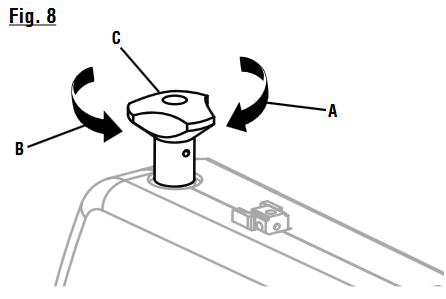
- To tighten
- To loosen
- Blade tension knob
- Turning the blade tension knob counterclockwise decreases (or loosens) blade tension.
- Turning the blade tension knob clockwise increases (or tightens) blade tension.
NOTE: Adjustments to blade tension can be made at any time.
Check tension by the sound the blade makes when plucked like a guitar string. This method of adding tension to the blade can be developed with practice and requires knowing the scroll saw.
- Pluck the back straight edge of blade while turning tension adjusting knob. Sound should be a musical note. Sound becomes less flat as tension increases. Sound decreases with too much tension.
NOTE: Be careful not to adjust blade too tight. Too much tension may cause the blade to break as soon as you start cutting. Too little tension may cause the blade to bend or break before the teeth wear out.
OPERATION
 WARNING:
WARNING:
Do not allow familiarity with products to make you careless. Remember that a careless fraction of a second is sufficient to inflict serious injury.
 WARNING:
WARNING:
Always wear eye protection with side shields marked to comply with ANSI Z87.1. Failure to do so could result in objects being thrown into your eyes, resulting in possible serious injury.
 WARNING:
WARNING:
Do not use any attachments or accessories not recommended by the manufacturer of this product. The use of attachments or accessories not recommended can result in serious personal injury.
APPLICATIONS
You may use this product for the following purposes:
- Cutting wood, wood composition products, plastic, and other fibrous material up to 2 in. thick
BASIC OPERATION OF THE UNIT
Before starting a cut, watch the saw run. If you experience excessive vibration or unusual noise, stop immediately. Turn the saw off, remove the switch key, and unplug the saw. Do not restart until locating and correcting the problem.
NOTE: After the saw is turned ON, a hesitation before blade movement is normal.
CUTTING PROCEDURES
- There is a learning curve for each person who wants to use this saw. During that period of time it is expected that some blades will break until you learn how to use and adjust the saw.
- Plan the way you will hold the workpiece from start to finish.
- Keep your hands away from the blade. Do not hand hold pieces so small your fingers will go under the blade guard.
- Hold the workpiece firmly against the saw table.
- The blade teeth cut material only on the down stroke.
- Use gentle pressure and both hands when feeding the work into the blade. Do not force the work.
- Guide the workpiece into the blade slowly because the teeth of the blade are very small and can only remove material on the down stroke.
- Avoid awkward operations and hand positions where a sudden slip could cause serious injury from contact with the blade. Never place hands in blade path.
- To get accurate cuts, compensate for the blade's tendency to follow the wood grain as you are cutting wood.
- Use extra supports (tables, saw horses, blocks, etc.) when cutting large, small or awkward workpieces.
- Never use another person as a substitute for a table extension or as additional support for a workpiece that is longer or wider than the basic saw table.
- When cutting irregularly shaped workpieces, plan your work so it will not pinch the blade. Workpieces must not twist, rock or slip while being cut.
REMOVING JAMMED MATERIAL
When backing out the workpiece, the blade may bind in the kerf (cut). This is usually caused by sawdust clogging the kerf or when the blade comes out of the blade holders. If this happens:
- Wait until the saw has come to a full and complete stop.
- Place the switch in the OFF position, remove the switch key from the switch assembly. Store key in a safe place.
- Unplug the saw from the power source.
- Remove the saw blade and the workpiece, see section on Installing and Removing the Blades.
- Wedge the kerf open with a flat screwdriver or wooden wedge then remove the blade from the workpiece.
 WARNING:
WARNING:
Before removing loose or jammed pieces from the table, turn saw off and wait for all moving parts to stop to avoid serious personal injury.
AVOIDING INJURY
- Make sure saw is level and does not rock. Saw should always be on a firm, level surface with plenty of room for handling and properly supporting the workpiece.
- Bolt saw to the support surface to prevent slipping, walking or sliding during operations like cutting long, heavy boards.
- Turn saw off, remove switch key, and unplug cord from the power source before moving the saw.
- Do not remove jammed cutoff pieces until blade has come to a full and complete stop.
- Choose the right size and style blade for the material and type of cut you plan to do.
- Use only recommended accessories.
- With the exception of the workpiece and related support devices, clear everything off the saw table before turning the saw on.
- Properly support round materials such as dowel rods or tubing because they have a tendency to roll during a cut causing the blade to "bite." To avoid this, always use a "V" block or clamp workpiece to a miter gauge
- Before removing loose pieces from the saw table, turn saw off and wait for all moving parts to stop.
LOCKING THE SWITCH
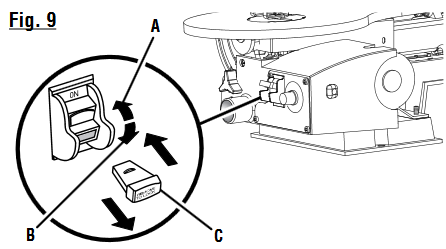
- Switch on
- Switch off
- Switch key removed
- Wait until the saw has come to a full and complete stop.
- Place the switch in theOFF position, then remove the switch key from the switch assembly. Store key in a safe place.
INSTALLING AND REMOVING BLADES
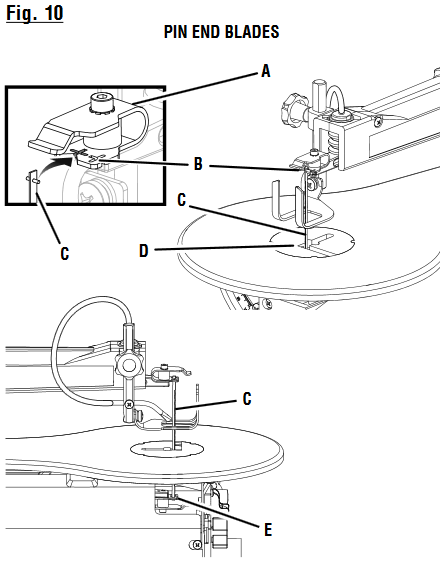
- Upper blade holder
- V-notch
- Saw blade
- Throat plate
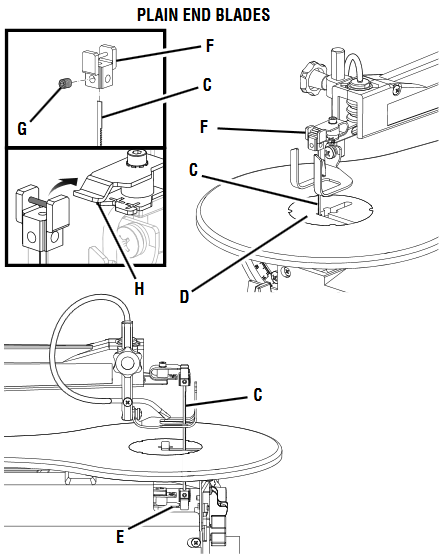
- Lower blade holder
- Blade clamp
- Blade clamp screw
- Tab
Scroll saw blades wear out quickly and must be replaced frequently for best cutting results. Expect to break some blades while you learn to use and adjust the saw. Blades generally stay sharp for 1/2 hour to 2 hours of cutting, depending on the type of material and speed of operation.
REMOVING THE BLADE
- Turn off and unplug the saw from the power source.
- Turn blade tension knob counterclockwise to decrease (or loosen) blade tension.
- Pushing up from under the saw table, remove the throat plate.
- Loosen both the upper and lower blade clamp screws.
- Pull up on the blade and push down on the saw arm to disengage the upper pin in the V-notch of the upper blade holder. Push the blade downward to disengage the lower pin in the V-notch of the lower blade holder.
- Remove the blade.
PIN END BLADES
- Turn off and unplug the saw from the power source.
- Remove the blade.
- Place the new blade through the opening in the saw table with the teeth to the front of the saw and pointing down toward the saw table. The pins on the blade go under the blade holder in the V-notch of the lower blade holder.
- Pull up on the blade and press the upper arm down to position the upper end of the blade in the V-notch in the upper blade holder.
- Securely tighten the upper and lower blade clamps by tightening the blade clamp screws.
- Turn the blade tension knob clockwise until the blade has the desired amount of tension.
- Replace the throat plate.
NOTE: If the blade touches the drop foot on either side then the drop foot must be adjusted. See section on "Drop Foot."
PLAIN END BLADES
- Turn off and unplug the saw from the power source.
- Remove the blade.
- Place the new blade through the opening in the saw table with the teeth to the front of the saw and pointing down toward the saw table.
- Position blade in the lower blade holder and tighten the blade clamp screw securely.
- Press the upper arm down to position the upper end of the blade in the upper blade holder.
- Securely tighten the upper blade clamp screw.
- Turn the blade tension knob clockwise until the blade has the desired amount of tension.
- Replace the throat plate.
NOTE: If the blade touches the drop foot on either side then the drop foot must be adjusted. See section Drop Foot.
BLADE INFORMATION
- Scroll saw blades wear out and must be replaced frequently for best cutting results. Scroll saw blades generally stay sharp for 1/2 hour to 2 hours of cutting, depending on type of material and speed of operation.
- In cutting wood, best results are achieved when cutting wood less than one inch thick.
- When cutting wood thicker than one inch, the user must guide the workpiece very slowly into the blade and take extra care not to bend or twist the blade while cutting.
- When choosing a blade, carefully consider the following:
- Very fine, narrow blades should be used to scroll cut in thin material 1/4 in. thick or less.
- Most blade packages state the size or thickness and type of material which that blade is intended to cut. The package should also state the radius or size of curve that can be cut with that blade size.
- Wider blades cannot cut curves as tight or as small as thinner blades.
- Blades wear faster when:
- Cutting plywood, hardwood, and other laminates.
- Cutting material thicker than 3/4 in.
- Side pressure is applied to the blade.
CHOICE OF BLADE AND SPEED
The scroll saw accepts a wide variety of blade widths and thicknesses for cutting wood and other fibrous materials. The saw uses 5 in. long blades of either the pin end or the plain end style. The blade width and thickness and the number of teeth per inch to use are determined by the type of material and the size of the radius being cut.
NOTE: As a general rule, always select narrow blades for intricate curve cutting and wide blades for straight and large curve cutting.
| Teeth/Inch | Width | Thickness | Speed or Strokes Per Minute | Material Cut |
| 10 | .110 in. | .020 in. | 1,200 - 1,600 | Popular size for cutting hard and soft woods 3/16 in. up to 2 in. Plastics, paper, felt, bone, etc. |
| 15 | .110 in. | .020 in. | - 1,200 | Wood, plastics, extremely thin cuts on materials 3/32 in.to 1/2 in. thick. |
| 18 | .095 in. | .010 in. | - 600 | For tight radius work in thin materials 3/32 in. to 1/8 in. Wood, veneer, bone, fiber, ivory, plastic, etc. |
USING VARIABLE SPEED
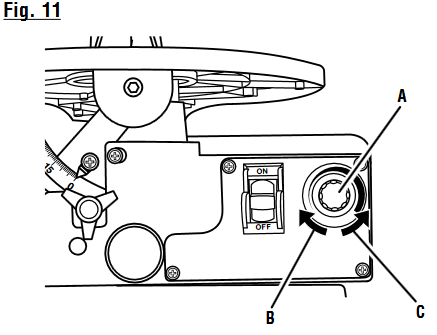
- Variable speed knob
- To increase
- To decrease
- By turning the variable speed knob, the saw's speed may be adjusted from a high speed of approximately 1,650 SPM (Strokes Per Minute) to a low speed of approximately 450 SPM.
- To increase the strokes per minute, turn the variable speed knob clockwise or to the right.
- To decrease the strokes per minute, turn the variable speed knob counterclockwise or to the left.
SCROLL CUTTING
For general type scroll cutting, follow the pattern lines by pushing and turning the workpiece at the same time. Do not try to turn the workpiece while engaged in the blade without pushing it – the workpiece could bind or twist the blade.
INTERIOR SCROLL CUTTING
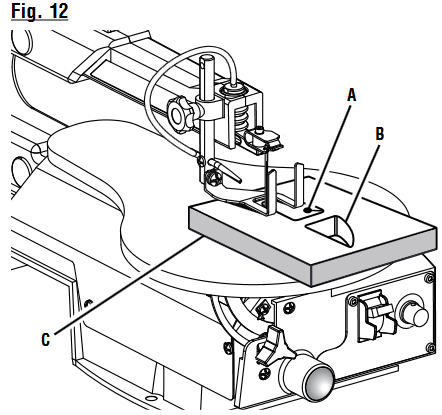
- Drill hole
- Interior cut
- Workpiece
- One feature of a scroll saw is that it can be used to make scroll cuts on the interior of a workpiece without breaking or cutting through the edge or perimeter of the board.
- To make interior cuts in the workpiece, remove the scroll saw blade as explained in the section on Installing and Removing Blades.
- Drill a 1/4 in. hole in the workpiece.
- Place the workpiece on the saw table with the drilled hole over the access hole in the table.
- Install blade through the hole in the workpiece; adjust the drop foot and blade tension.
- When finished making the interior scroll cuts, simply remove the blade from the blade holders as described in the section on Installing and Removing Blades and remove the workpiece from the saw table.
STACK CUTTING
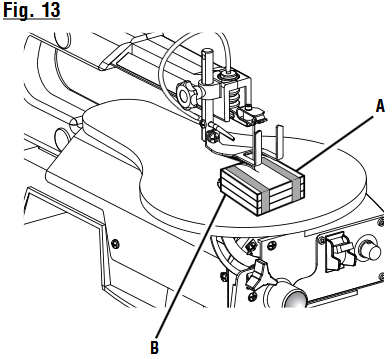
- Tape
- Wood pieces
After becoming well acquainted with the saw through practice and experience, you may wish to try stack cutting. Stack cutting may be used when several identical shapes need to be cut. Several pieces of wood may be stacked on top and secured to each other before cutting. The wood pieces may be joined together by placing double sided tape between each piece or by wrapping masking tape around the corners or ends of the stacked wood. You must attach the stacked pieces of wood to each other so they will move on the table as a single piece of material.
MAINTENANCE
 WARNING:
WARNING:
When servicing, use only identical replacement parts. Use of any other parts can create a hazard or cause product damage.
 WARNING:
WARNING:
Always wear eye protection with side shields marked to comply with ANSI Z87.1. Failure to do so could result in objects being thrown into your eyes, resulting in possible serious injury.
GENERAL MAINTENANCE
Avoid using solvents when cleaning plastic parts. Most plastics are susceptible to damage from various types of commercial solvents and may be damaged by their use. Use clean cloths to remove dirt, dust, oil, grease, etc.
 WARNING:
WARNING:
Do not at any time let brake fluids, gasoline, petroleumbased products, penetrating oils, etc., come in contact with plastic parts. Chemicals can damage, weaken, or destroy plastic which could result in serious personal injury.
- Keep the saw clean.
- After cleaning the table top initially, apply a thin coat of automobile type (paste) wax to the table top so the wood slides easily while cutting.
- Do not allow pitch to accumulate on the saw table. Clean with gum and pitch remover. Do not use gasoline.
Electric tools used on fiberglass material, wallboard, spackling compounds, or plaster are subject to accelerated wear and possible premature failure because the fiberglass chips and grindings are highly abrasive to bearings, brushes, commutators, etc. Consequently, we do not recommended using this product for extended work on these types of materials. However, if you do work with any of these materials, it is extremely important to clean the product using compressed air.
ARM BEARINGS
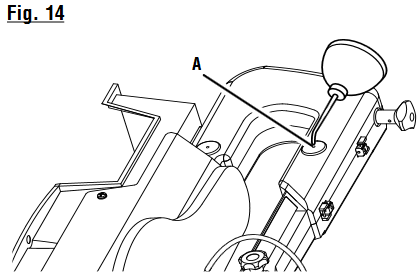
- Arm bearing
Lubricate the arm bearings after the first 10 hours of use. Oil after every 50 hours of use or whenever there is a squeak coming from the bearings.
- Carefully place the saw on its side as shown. Remove the rubber cap from the upper and the lower arm of the saw.
- Squirt a few drops of SAE20 oil around the shaft end and arm bearings. Let oil soak in overnight, remaining in this position.
NOTE: Lubricate the bearings on the other side of the saw in this same manner.
MOTOR BRUSHES
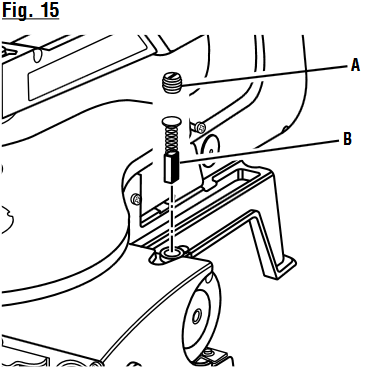
- Brush cap
- Motor brush
The saw has externally accessible motor brush assemblies that should be checked periodically for wear. When one of the two brushes becomes worn, replace both brushes.
- Unplug the saw from the power source.
- Carefully place the saw on its side exposing the underside of the saw housing.
- Using a flat blade screwdriver, remove the bottom brush assembly cap through the access hole in the base and the top brush assembly cap from the top of the motor. Gently pry the brush assemblies out using a small screwdriver, point of a nail, or paper clip.
- If one motor brush is worn down shorter than 1/4 in. (6 mm), replace both motor brushes. Do not replace one side without replacing the other. Make sure curvature of brush matches curvature of motor and that the motor brush moves freely in brush tube. Use the blunt end of something thin (eraser end of pencil, etc.) to push the motor brush into the tube until it stays.
- Make sure the motor brush cap is oriented correctly (straight). Tighten motor brush cap using a hand powered screwdriver only. Do not overtighten.
TROUBLESHOOTING
| PROBLEM | CAUSE | SOLUTION |
Motor will not run | Problem with ON-OFF switch, power cord, or outlet. | Have worn parts replaced before using scroll saw again. Have the proper outlet installed by a qualified electrician. |
| Motor defective. | Do not attempt any repair. Have repaired by a qualified service technician. | |
Blades breaking | Too much tension. | Adjust tension. |
| Feeding too quickly. | Reduce feed rate. | |
| Wrong blade. | Narrow blades for cutting thin wood or tight corners and turns, wide blades for thicker wood or wide turns. | |
| Blade twisting in wood. | Reduce side pressure on blade; check blade tension. | |
Vibration(there is always some vibration when the saw is running) | Improper mounting of saw. | Check mounting. |
| Mounting surface. | Check mounting in manual. | |
| Loose table or table resting against motor. | Tighten table lock knob. | |
| Loose motor mounting. | Tighten mounting screws. | |
Blade runout(blade not properly aligned with arm motion) | Blade holders out of line. | Realign blade. |
REGISTER YOUR TOOLS
http://register.ryobitools.com
1-800-525-2579
Documents / Resources
References
Download manual
Here you can download full pdf version of manual, it may contain additional safety instructions, warranty information, FCC rules, etc.
Advertisement




















Need help?
Do you have a question about the SC165VS and is the answer not in the manual?
Questions and answers